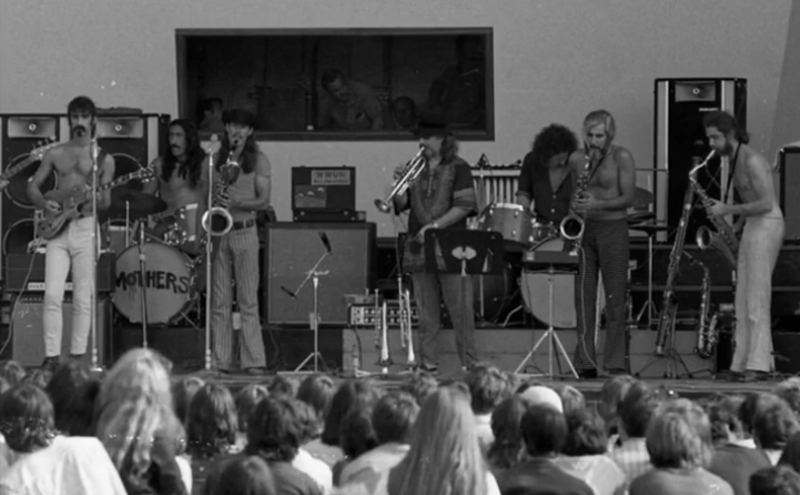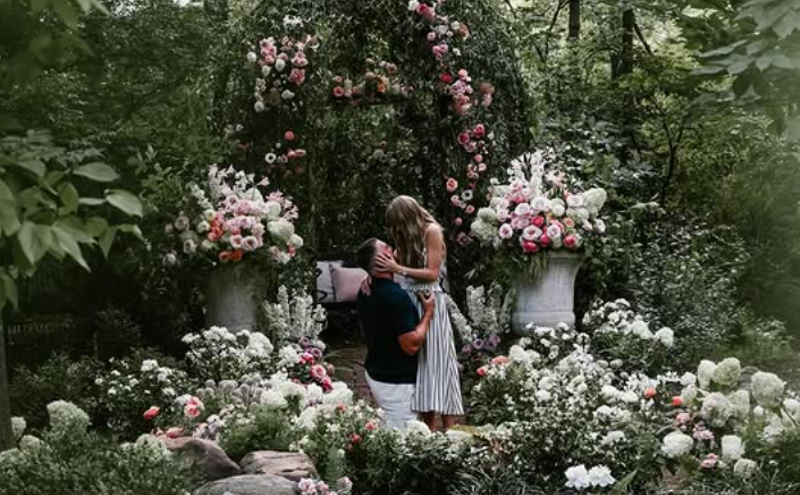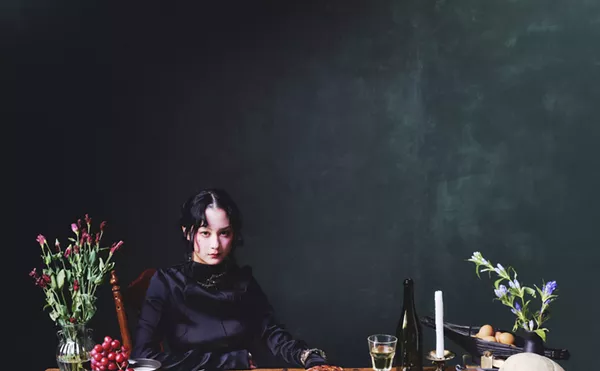Editor's Note: On Thursday, October 13, Bob Dylan was announced as the 2016 winner of the Nobel Prize in Literature. What follows is an in-depth look back at his short but likely formative time in Denver as a young unknown — and unpopular — folk singer in the summer of 1960.
In the early summer of 1960, Bob Dylan, then a resident of Dinkytown, a bohemian neighborhood in Minneapolis, was getting ready to head out west to Denver, Colorado.
Only Dylan can say for certain what it was that motivated him to make Denver his destination or how it was that he got here. According to Robert Shelton, author of No Direction Home, it was Monte Edwardson, Dylan’s high school bandmate, who told him about Denver’s lively folk-music scene.
Shortly after arriving, Dylan made his way to the Satire Lounge, at 1920 East Colfax. A girl Bob knew suggested that he introduce himself to Walt Conley, a singer who was managing and performing at the Satire, according to Down the Highway, Howard Sounes’s seminal biography of the singer. Advertised as “a pleasant place to spend an evening,” the Satire was owned by Sam Sugarman, who in 1960 renamed and revamped the former sports bar Sugie’s Lounge into a folk venue in order to cash in on the growing folk music scene in Denver.
Conley, born in Denver in 1929, was a folk singer and actor who is still considered a local treasure in the folk community. Conley was introduced to folk music while working a summer job on a dude ranch outside of Taos. It was there that he met Pete Seeger. According to his obituary in the Denver Post, Conley received his first guitar from Seeger, “who liked Conley's rich baritone and taught him to use it to his advantage in folk songs.” Conley quickly became a fixture in Denver's folk music scene, playing bars around town and providing opportunities for others to do so as well, particularly at the Satire.
According to Sounes, Conley described the young Dylan as “looking like a character out of The Grapes of Wrath.” Wearing worn-out clothes and singing hillbilly ballads, Conley noted, Dylan was from the branch of folk music that was “rolling in the dust,” with a style and look that contrasted with the more polished branch of folk musicans, such as the Kingston Trio, which was popular in Denver at the time. The Smothers Brothers were also a Denver-based favorite, whom Conley had befriended while playing a gig in Aspen and then later booked at the Satire.
Dylan asked Conley if he could play, and Conley agreed to let him do some short afternoon sets before the Smothers Brothers went on. Conley had also agreed to let Dylan stay at his house on East 17th Avenue near Williams Street, a short distance from the Satire, but he would have to sleep on the floor, as all of Conley’s rooms were occupied by other musicians. After staying one night on Conley’s floor, Dylan started bouncing around town looking for places to stay and play. He ended up in a rented room next door to the Raylane Hotel, which was located at 1999 Lincoln Street, on the southwest corner at 20th Avenue.
The Raylane Hotel
According to Rob Simon in an article for Westword, the Raylane, originally named the Toovey Hotel, was a four-story, 62-room hotel built in 1901 by German businessman William Toovey. In 1960 it catered to Denver's low-income residents. The summer before Dylan arrived in Denver, Hal Neustaedter, an area real-estate broker, opened Denver's first “bohemian nightclub,” the Exodus Gallery Bar, in Raylane's garden level. In the spring of 1960, Neustaedter opened the Exodus Catacombs, a private club for teenagers, in the basement beneath the Gallery Bar. Neustaedter was not only a businessman, but a fan of folk music, giving musicians and wannabe musicians a place to perform for an audience. The Exodus and the Catacombs developed a reputation as the place to go in Denver to hear folk music, and the venues were a favored booking for folk musicians touring between Chicago and the West Coast.
At the Exodus, patrons drank 3.2 beer served out of buckets, enjoyed the atmosphere — particularly the walls, which were plastered with “high-camp” posters and impressionistic paintings — and, of course, listened to the music. The Exodus was also known as the place where Denver's most interesting characters hung out. In a Rocky Mountain News article from September 6, 1959, Bob Whearley writes about a girl in a black eye patch sitting in the “smoky half-lit room,” enjoying the music of Walt Conley.
There is no evidence that Dylan performed at the Exodus. Neustaedter was known for being very picky about who graced his stages, and there is no indication that he knew who Dylan was or had ever listened to him play. Regardless, this didn’t keep Dylan from checking out other musicians at the clubs that summer, including Jesse Fuller.
Jesse “Lone Cat” Fuller
It was not unusual for two different musical acts to be performing in both clubs at the Exodus. One popular act in the Catacombs was Jesse “Lone Cat” Fuller, a blues guitar player. Fuller was born in Jonesboro, Georgia, in 1896, and during his childhood built a mouth bow and his first guitar. He taught himself how to play by sneaking into shows. Throughout his adolescence, he worked odd jobs and learned traditional folk and blues songs on both the harmonica and guitar.
As an adult, Fuller hopped a freight train to California, working odd jobs and busking for money, ultimately appearing in films in bit parts. He landed a job icing cars for the railroad and went back to Georgia to find a wife. After he returned to California — specifically, the San Francisco Bay area — he continued to hone his musical ability and invented the “fotdella,” a six-string bass viol that he worked with his foot via a system of levers and pedals, which earned him the moniker “one-man band.”
Fuller's folk career took off, and he played in folk venues throughout the state of California. He caught his big break at the Monterey Jazz Festival in 1959 and toured Europe. After the tour, he played in Denver, where he met Dylan during a show at the Exodus Catacombs. Dylan took note of the way that Fuller held his harmonica in front of his mouth in a metal neck brace, which allowed him to alternate between singing and running riffs on the harmonica, eventually incorporating the device into his own act and some of Fuller’s songs into his set list.
Dylan would later record Fuller's “You're No Good” on his debut album in 1961, and on April 20-22 of 1962, Dylan shared the bill with Fuller at the University of Michigan Folk Festival in Ann Arbor. Marie Kimmey, prior president of the Folklore Society in Ann Arbor, who arranged the appearance, recollected that the unknown “Bob Dillon,” as his name appeared in the ad for the event, was paid fifty dollars for the gig. Kimmey said, “We were thrilled to be pulling this off, and for only fifty bucks. We knew he was going to go places.” By the close of April 1962, Dylan was in the studio recording his second album, The Freewheelin' Bob Dylan.
Back at the Satire in 1960, however, the Smothers Brothers, according to Sounes, let Conley know they didn’t like the “faux hobo” Dylan. A call from Sophia St. John in Central City let Conley off the hook. St. John told Conley she was “looking for a singer up here,” and Conley suggested Dylan because he was “underfoot” and in the way. Dylan jumped at the offer and headed into the mountains along Clear Creek toward Central City by thumb and by bus.
Central City Gig at the Gilded Garter
Sophia St. John ran the Gilded Garter (now the closed Doc Holliday Casino), located in the Harris Block on Main Street in Central City, a former Gold Rush town established in 1859 in the mountains west of Denver. Built in 1890 by Ed Harris, the Harris Block building first contained a mortuary in 1891, and a second floor was added in 1897. The building later functioned as the Adler Hotel. After World War II, a board-and-batten false front was installed, and the Gilded Garter was born.
Described by Dylan as a strip joint (Shelton), a description possibly influenced by the paintings of nude women on the walls, the Gilded Garter was actually a noisy tourist bar in a tourist town. Dylan performed between the “strip acts,” describing the situation thusly: “As the night got longer, the air got heavier, the audience got drunker and nastier and then I got sicker and finally I got fired.” Dylan elaborated on his time in Central City while visiting the town during a concert stop in 1966: “When I first went up here, Central City seemed so far from anything I'd ever seen or done before, it was sort of magic for me.” Shelton and Dylan walked down the streets while Bob reminisced about his time there. “Oh, it only lasted a few weeks, but I suppose I'll never forget it,” Shelton quotes Dylan as saying. He continued, “They paid me very little, but they threw in sandwiches and drinks, and all the strippers I could watch. All the noisy drunks were thrown in free, too. The time has gone so fast. It almost seems like it happened to someone else.”
Leaving Denver
As the summer wound down and the brief Gilded Garter gig ended, Dylan returned to Denver. As he was no longer welcome at the Satire (partly because of the antipathy of the established Smothers Brothers) and unable to land a gig at the Exodus, it was clear that Denver was not going to give Dylan a place in its burgeoning folk scene. As suggested by Conley, Denver “wasn’t buying Bob Dylan.” Dylan was a traditionalist Guthrie-type of folksinger in a Kingston Trio kind of town.
After he returned to the city, Dylan was accused of stealing records from Conley’s collection by Dave Hamil, another musician who found refuge at Conley’s house. Suggesting that the missing records were not of Dylan’s musical taste, Hamil concluded that Dylan must have stolen the records to sell. Hamil confronted Dylan at his rented room next to the Exodus and accused him of stealing the records. Dylan denied the charge and locked Hamil out of his room. Hamil then called the police. Dylan, who actually did have the records (which he admitted to later), may have thrown them out the third-floor window down into the alley below. Hamil retrieved the records from the alley and urged Conley, who had finally arrived at the hotel, to press charges. Conley declined.
Dylan left the city soon thereafter, summing up the incident as follows: “I was run out of Denver for robbing a cat’s house.”
Bound for Glory
“Get me a freight train head down the track. You'll have to put out a load of money boys for to get me back.” - "Colorado Blues" (Dylan, 1961)
Dylan left Denver, briefly returning to Dinkytown. While Denver was not the success he probably hoped it would be, it provided him with anonymity and a chance to romanticize his background, as Shelton points out. To friends and family back east, Dylan claimed he was well received in Denver.
Meeting Jesse Fuller was certainly fortuitous when you consider Dylan’s sound on later albums and his later image of the singer-songwriter with his acoustic guitar and racked harmonica — a figure that's become synonymous with Dylan. And Fuller’s music clearly had an influence on Dylan, who recorded Fuller’s song “You’re No Good” on his debut album. Conley also gave Dylan a new topical anti-KKK song, “The Klan,” to add to his playlist, which Dylan was known to have played following his time in Denver. Not the typical folk song, it’s no surprise that the guy who would eventually write “Only a Pawn in Their Game” would find this Conley song appealing.
Whatever the combination of reasons for his departure, Dylan left Denver and headed back down the highway, Martin Double-O in hand, worn-out look, and perhaps a new song in mind. Perhaps a twelve-bar blues alluding to a struggle past and gone. Perhaps his 1961 song, "Colorado Blues," which contains the following lyrics:
Got Colorado blues I feel so bad,
Got Colorado blues I feel so bad,
Thinking about the times I once had
Central City ain't no friend of mine,
Central City ain't no friend of mine.
Denver town's a sad kind of place to stay,
I wish I was back in the good ol' USA.
Get me a freight train head down the track,
You'll have to put out a load of money boys for to get me back.
1964 : Return to Denver
On February 15, 1964, the 22-year-old Bob Dylan made his first return trip to Denver since the summer of 1960 for an 8:30 p.m. concert at Denver Civic Auditorium Theatre. The ad for the upcoming show appeared under an Exodus ad in the Rocky Mountain News. The concert was to promote the January ’64 release of his album The Times They Are A-Changin’. Tickets were available at Denver’s Folklore Center for $2 and $3. None of the local papers noted Dylan’s previous time in Denver. An article in the Rocky announcing the concert noted that Dylan,“a legend,” seemed to have come out of nowhere, another unknown in Greenwich Village who now “sits at the peak of the folk music movement.” In the same article, Alan Lomax is quoted as saying that Bob Dylan “worked long and hard, like a demon, to learn the folk tradition.” It’s suggested that the song “Chimes of Freedom,” which would appear on his album Another Side of Bob Dylan, released later in 1964, was also debuted at this concert.
A review of the concert by Dennis Riley in the Rocky on February 16, 1964, noted that “Denver’s younger generation flocked to the Auditorium Theater Saturday night to hear singer Bob Dylan present an informal concert of folk music.” Riley went on to critique Dylan as lacking musical talent and imagination and called him a man of “routine clichés” that lack “real feeling.” Riley continued, “Instead of the distinctive folk element contained in songs polished by generations of roving singers, there was to be heard the less refined doggerel of country and western style.”
Denver Buys Dylan
Since 1964, Bob Dylan has continued to pack houses in Denver and inspire generations to celebrate his life and work when he’s not here. Stop in at any coffeehouse for live music or a local dive’s open-mic night and you’ll find at least one person with a harmonica rack around his neck performing Dylan style. In May 2016, the 11th Annual Bob Dylan Birthday Tribute Music & Art Show (this year called Bob Dylan’s 75th Birthday Bash) was held at the Oriental Theater. Also in May was the 10th Annual All Star Tribute to Bob Dylan, with various musicians performing, including folksinger Harry Tuft, who is often referred to as Denver’s godfather of folk music. Tuft opened the Denver Folklore Center in 1962, now located at 1893 South Pearl Street.
Another Denver summer is approaching, and Bob Dylan will once again return to the area. The legendary song-and-dance man, who just celebrated his 75th birthday on May 24, will be in town for a show at Red Rocks on June 19. “Don’t you dare miss it!!”

Audio By Carbonatix
[
{
"name": "GPT - Billboard - Slot Inline - Content - Labeled - No Desktop",
"component": "23668565",
"insertPoint": "2",
"requiredCountToDisplay": "2"
},{
"name": "STN Player - Float - Mobile Only ",
"component": "23853568",
"insertPoint": "2",
"requiredCountToDisplay": "2"
},{
"name": "Editor Picks",
"component": "17242653",
"insertPoint": "4",
"requiredCountToDisplay": "1"
},{
"name": "Inline Links",
"component": "18838239",
"insertPoint": "8th",
"startingPoint": 8,
"requiredCountToDisplay": "7",
"maxInsertions": 25
},{
"name": "GPT - 2x Rectangles Desktop, Tower on Mobile - Labeled",
"component": "24956856",
"insertPoint": "8th",
"startingPoint": 8,
"requiredCountToDisplay": "7",
"maxInsertions": 25
},{
"name": "Inline Links",
"component": "18838239",
"insertPoint": "8th",
"startingPoint": 12,
"requiredCountToDisplay": "11",
"maxInsertions": 25
},{
"name": "GPT - Leaderboard to Tower - Slot Auto-select - Labeled",
"component": "17676724",
"insertPoint": "8th",
"startingPoint": 12,
"requiredCountToDisplay": "11",
"maxInsertions": 25
}
]










